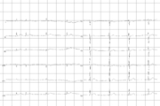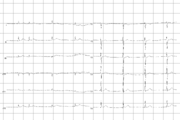
Sick sinus syndrome
Encyclopedia


Causes
Sick sinus syndrome is a relatively uncommon syndrome. It can result in many abnormal heart rhythms (arrhythmias), including sinus arrest, sinus node exit block, sinus bradycardiaSinus bradycardia
Sinus bradycardia is a heart rhythm that originates from the sinus node and has a rate of under 60 beats per minute.-Signs and symptoms:The decreased heart rate can cause a decreased cardiac output resulting in symptoms such as lightheadedness, dizziness, hypotension, vertigo, and syncope...
, and other types of bradycardia
Bradycardia
Bradycardia , in the context of adult medicine, is the resting heart rate of under 60 beats per minute, though it is seldom symptomatic until the rate drops below 50 beat/min. It may cause cardiac arrest in some patients, because those with bradycardia may not be pumping enough oxygen to their heart...
(slow heart rate).
Sick sinus syndrome may also be associated with tachycardia
Tachycardia
Tachycardia comes from the Greek words tachys and kardia . Tachycardia typically refers to a heart rate that exceeds the normal range for a resting heart rate...
s (fast heart rate) such as paroxysmal supraventricular tachycardia (PSVT) and atrial fibrillation. Tachycardias that occur with sick sinus syndrome are characterized by a long pause after the tachycardia.
Abnormal rhythms are often caused or worsened by medications such as digitalis
Digitalis
Digitalis is a genus of about 20 species of herbaceous perennials, shrubs, and biennials that are commonly called foxgloves. This genus was traditionally placed in the figwort family Scrophulariaceae, but recent reviews of phylogenetic research have placed it in the much enlarged family...
, calcium channel blocker
Calcium channel blocker
A calcium channel blocker is a chemical that disrupts the movement of calcium through calcium channels.CCB drugs devised to target neurons are used as antiepileptics. However, the most widespread clinical usage of calcium channel blockers is to decrease blood pressure in patients with...
s, beta-blockers, sympatholytic medications, and anti-arrhythmics. Disorders that cause scarring, degeneration, or damage to the conduction system can cause sick sinus syndrome, including sarcoidosis
Sarcoidosis
Sarcoidosis , also called sarcoid, Besnier-Boeck disease or Besnier-Boeck-Schaumann disease, is a disease in which abnormal collections of chronic inflammatory cells form as nodules in multiple organs. The cause of sarcoidosis is unknown...
, amyloidosis
Amyloidosis
In medicine, amyloidosis refers to a variety of conditions whereby the body produces "bad proteins", denoted as amyloid proteins, which are abnormally deposited in organs and/or tissues and cause harm. A protein is described as being amyloid if, due to an alteration in its secondary structure, it...
, Chagas' disease, and cardiomyopathies.
Sick sinus syndrome is more common in elderly adults, where the cause is often a non-specific, scar-like degeneration of the cardiac conduction system
Electrical conduction system of the heart
The normal intrinsic electrical conduction of the heart allows electrical propagation to be transmitted from the Sinoatrial Node through both atria and forward to the Atrioventricular Node. Normal/baseline physiology allows further propagation from the AV node to the ventricle or Purkinje Fibers...
. Cardiac surgery, especially to the atria
Atria
Atria may refer to:*Atrium , an anatomical structure of the heart*Atrium , a large open space within a building*Atria or Alpha Trianguli Australis, a star in the constellation Triangulum Australe...
, is a common cause of sick sinus syndrome in children.
Coronary artery disease, high blood pressure, and aortic and mitral valve diseases may be associated with sick sinus syndrome, although this association may only be incidental. The mechanism is related to delayed escape. Congenital SSS is due to mutations of gene responsible for formation of Alpha subunit of sodium channel.
A Russian study showed that the heterozygous variant of connexin 40 polymorphism gene variant is more frequent among patients with sick sinus node syndrome and their healthy relatives than in persons of control group, suggesting a link between the gene and the disease.
Symptoms
Even though many types of sick sinus syndrome produce no symptoms, patients may present with:- Stokes-Adams attackStokes-Adams attackStokes–Adams syndrome refers to a sudden, transient episode of syncope, occasionally featuring seizures. It is named after two Irish physicians, Robert Adams and William Stokes .-Signs and symptoms:...
s - fainting due to asystoleAsystoleIn medicine, asystole is a state of no cardiac electrical activity, hence no contractions of the myocardium and no cardiac output or blood flow...
or ventricular fibrillationVentricular fibrillationVentricular fibrillation is a condition in which there is uncoordinated contraction of the cardiac muscle of the ventricles in the heart, making them quiver rather than contract properly. Ventricular fibrillation is a medical emergency and most commonly identified arrythmia in cardiac arrest... - Dizziness or light-headedness
- Palpitations
- Chest pain or angina
- Shortness of breath
- Fatigue
- Headache
- Nausea
- Fainting
Diagnosis
Ambulatory monitoring of the electrocardiogramElectrocardiogram
Electrocardiography is a transthoracic interpretation of the electrical activity of the heart over a period of time, as detected by electrodes attached to the outer surface of the skin and recorded by a device external to the body...
(ECG) may be necessary because arrhythmias are transient. The ECG may show any of the following
- Inappropriate sinus bradycardia
- Sinus arrest
- Sinoatrial block
- Atrial fibrillation with slow ventricular response
- A prolonged asystolic period after a period of tachycardias
- Atrial flutter
- Ectopic atrial tachycardia
- Sinus node reentrant tachycardia
Electrophysiologic tests are no longer used for diagnostic purposes because of their low specificity and sensitivity. Cardioinhibitory n vasodepressor forms of sick sinus syndrome may be revealed by tilt table testing.
Treatment
Artificial pacemakersArtificial pacemaker
A pacemaker is a medical device that uses electrical impulses, delivered by electrodes contacting the heart muscles, to regulate the beating of the heart...
have been used in the treatment of sick sinus syndrome.
Bradyarrhythmias are well controlled with pacemakers, while tachyarrhythmias respond well to medical therapy.
However, because both bradyarrhythmias and tachyarrhythmias may be present, drugs to control tachyarrhythmia may exacerbate bradyarrhythmia. Therefore, a pacemaker is implanted before drug therapy is begun for the tachyarrhythmia.

